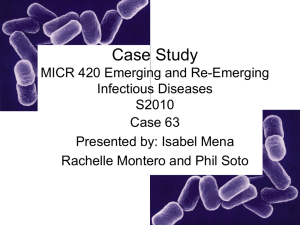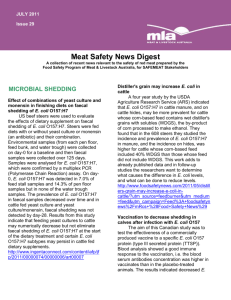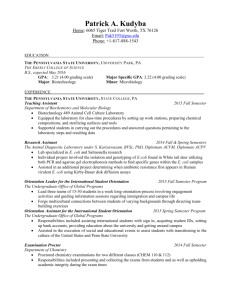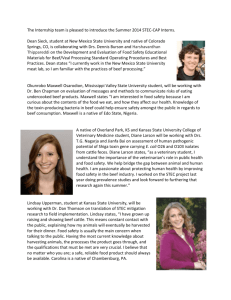Jan 2010 - Food Safety Centre
advertisement
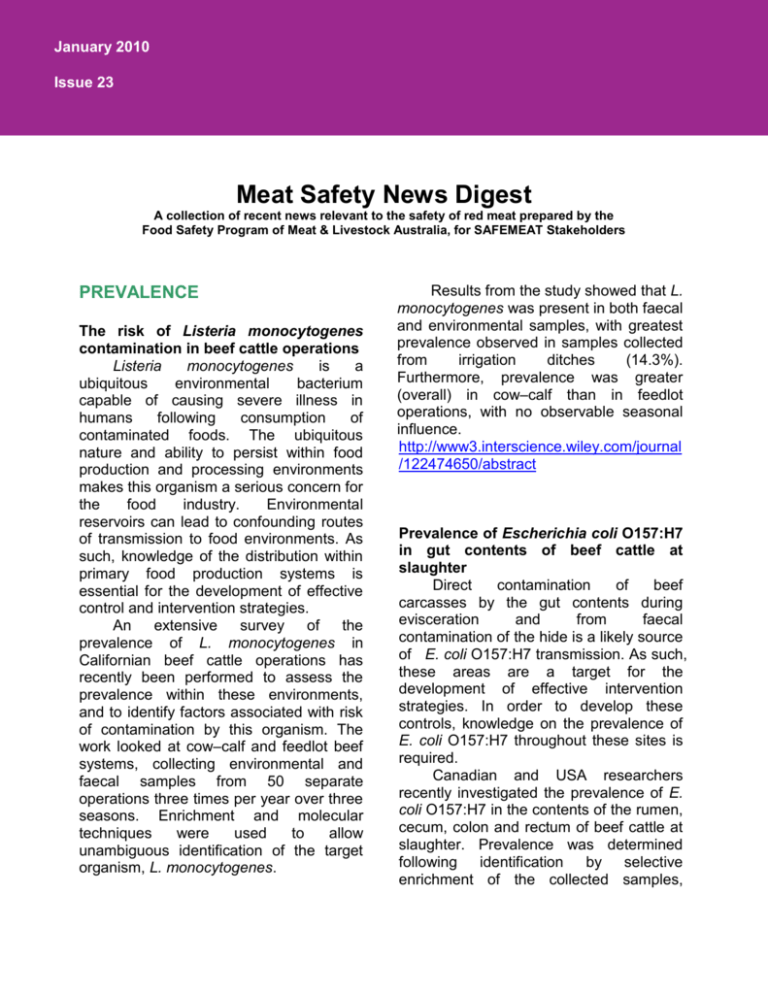
January 2010 Issue 23 Meat Safety News Digest A collection of recent news relevant to the safety of red meat prepared by the Food Safety Program of Meat & Livestock Australia, for SAFEMEAT Stakeholders PREVALENCE The risk of Listeria monocytogenes contamination in beef cattle operations Listeria monocytogenes is a ubiquitous environmental bacterium capable of causing severe illness in humans following consumption of contaminated foods. The ubiquitous nature and ability to persist within food production and processing environments makes this organism a serious concern for the food industry. Environmental reservoirs can lead to confounding routes of transmission to food environments. As such, knowledge of the distribution within primary food production systems is essential for the development of effective control and intervention strategies. An extensive survey of the prevalence of L. monocytogenes in Californian beef cattle operations has recently been performed to assess the prevalence within these environments, and to identify factors associated with risk of contamination by this organism. The work looked at cow–calf and feedlot beef systems, collecting environmental and faecal samples from 50 separate operations three times per year over three seasons. Enrichment and molecular techniques were used to allow unambiguous identification of the target organism, L. monocytogenes. Results from the study showed that L. monocytogenes was present in both faecal and environmental samples, with greatest prevalence observed in samples collected from irrigation ditches (14.3%). Furthermore, prevalence was greater (overall) in cow–calf than in feedlot operations, with no observable seasonal influence. http://www3.interscience.wiley.com/journal /122474650/abstract Prevalence of Escherichia coli O157:H7 in gut contents of beef cattle at slaughter Direct contamination of beef carcasses by the gut contents during evisceration and from faecal contamination of the hide is a likely source of E. coli O157:H7 transmission. As such, these areas are a target for the development of effective intervention strategies. In order to develop these controls, knowledge on the prevalence of E. coli O157:H7 throughout these sites is required. Canadian and USA researchers recently investigated the prevalence of E. coli O157:H7 in the contents of the rumen, cecum, colon and rectum of beef cattle at slaughter. Prevalence was determined following identification by selective enrichment of the collected samples, immunomagnetic separation, further plating on selective medium, agglutination for the O157 antigen, and molecular detection of virulence genes. This lengthy process allowed for unambiguous identification. In addition to identification, the relatedness of isolates from each location was established using a molecular finger printing technique (pulsed-field gel electrophoresis). This allowed the researchers to determine if the recovered E. coli O157:H7 isolates originated from a common progenitor, suggesting persistent rather than sporadic contamination of the animals. Finally isolates recovered from pre- and postgastric locations were subjected to an acid challenge to determine resistance to low pH environments. This was targeted at determining if the strains were adapted to life within specific regions of the beef cattle gut environment. Results showed the prevalence in the rumen, cecum, colon, and rectum to be 4.9%, 9.9%, 7.6%, and 11.1% respectively, with the hind gut showing highest prevalence overall. The majority of the isolates recovered from the same animal were related, suggesting a common progenitor. Acid challenge of isolates recovered from pre-gastric and post-gastric locations showed no significant difference. This study identified important characteristics of E. coli O157:H7 localisation within the gastrointestinal tract of beef cattle, and highlights potential focus areas for future research on intervention strategies targeted at E. coli O157:H7. http://www.liebertonline.com/doi/abs/10.10 89/fpd.2009.0410 CONTAMINATION AND CONTROL Field tests planned for E. coli vaccines A vaccine targeting E. coli O157:H7 in cattle would provide a valuable addition to the current multi-step intervention strategies targeted at this organism. A promising new vaccine against E. coli O157:H7 is set to undergo extensive field trials in the USA. Vaccines against the organism have been in development since 2001. The vaccine will be administered to approximately 400,000 cattle in the tests. While the vaccine has been demonstrated to be effective at reducing the prevalence of E. coli O157:H7 in cattle by 65–75%, it is not known whether it is economically viable. The latest testing is aimed at assessing this, and represents one of the final milestones prior to commercial release. However, at $3 (US) a dose, with two to three doses recommended, it is suggested that the vaccine may be too costly at this stage for wide spread use. http://www.foodsafetynews.com/2009/12/l arge-field-tests-for-e-coli-o157h7vaccines/ Does acid resistance give E. coli an advantage in beef cattle and can adding probiotics inhibit them? Resistance to low pH environments is believed to be advantageous for survival of E. coli strains within the acidic environment of the ruminant gastrointestinal tract. This could facilitate persistent colonisation of the ruminant gastrointestinal tract and provide a reservoir of “acid resistant” E. coli strains capable of surviving acid-based cleaning/sanitising treatments. In a recent French study, researchers investigated whether acid resistant E. coli strains (Shiga-toxigenic) have an advantage in the ruminant digestive tract and whether acid resistance mechanisms are induced in this environment. Additionally, the researchers assessed whether adding probiotics (beneficial microbial strains) affects the survival of these E. coli strains. Results from the study showed acid resistant strains did indeed survive longer in rumen fluid; however following movement through this region, acid resistant and acid sensitive strains survived at similar levels. Probiotic supplementation during prolonged rumen incubations killed all of the strains tested, independent of acid resistance. However, the addition of probiotics had no effect on survival of the E. coli strains in digestive compartments other than the rumen. The work highlights the potential for targeting the rumen compartment to limit induction of acid resistance in Shigatoxigenic E. coli. This could decrease further passage through the digestive tract and shedding into the environment, and subsequently decrease the risk of contamination and transmission to foods and food production areas. http://aem.asm.org/cgi/content/abstract/A EM.02054-09v1 Comparison of the sanitisation potency of slightly acidic electrolysed water with other food sanitisers Studies aimed at improving the effectiveness of sanitisers and sanitising methods are of benefit to all food industries. Japanese researchers have investigated the efficacy of slightly acidic electrolyzed water (SAEW, pH5.8, 21mg/L available chlorine) for sanitisation of pure cultures of Staphylococcus aureus and E. coli in comparison to strong acidic electrolyzed water (pH<5.0) and sodium hypochlorite solution which are already widely used. The efficacy of the sanitising agents was assessed at 30, 60 and 90 seconds exposure time. The order of bacterial reduction efficacy at each exposure time was found to be: strong acidic electrolysed water > sodium hypochlorite> slightly acidic electrolysed water. This was found to increase with exposure time (90 s > 60 s > 30 s) for all of the sanitisers tested. The authors concluded that SAEW could be useful as a more gentle replacement of sodium hypochlorite, which is commonly used in food industry, to obtain similar sanitisation results. http://www.sciencedirect.com/science?_ob =ArticleURL&_udi=B6T6S-4XP37S51&_user=10&_rdoc=1&_fmt=&_orig=searc h&_sort=d&_docanchor=&view=c&_acct= C000050221&_version=1&_urlVersion=0& _userid=10&md5=7a374dd97ba5ffdb6423 4f29ec14b0e3 Plasmid O157 influences E. coli O157:H7 biofilm formation E. coli has a range of mechanisms that allow it to survive under adverse environmental conditions. Specific molecular components of E. coli, under the direction of the organism’s genetic code, are known to be responsible for these survival mechanisms. However, many remain to be identified. Knowledge of the molecular mechanisms underpinning survival under adverse conditions could allow scientists to develop highly specific intervention strategies against this organism. A well known survival strategy by E. coli is the ability to form biofilms. Biofilms are structured communities of microbes embedded within a “self-produced” organic substance that are irreversibly adhered to a surface. They afford considerable protection to the resident microbes and can be extremely resistant to cleaning and sanitising procedures, therefore providing a means of persistence within food production facilities. Recently, scientists have determined that a specific E. coli H7:O157 genetic element (plasmid O157) plays a role in the adherence to surfaces and production of key biofilm substances that strengthen these structures. This is the first time that this element has been associated with biofilms. The findings may represent a means of screening for high risk E. coli populations, and could lead to a target for the removal and control of biofilms within the food production environment. http://aem.asm.org/cgi/content/abstract/A EM.01068-09v1?etoc Responses of E. coli O157:H7, L. monocytogenes and Salmonella enteritidis to pH, water activity and temperature stress combinations E. coli O157:H7, Listeria monocytogenes and Salmonella enteritidis are bacteria capable of surviving under a range of adverse conditions. This can lead to persistent contamination of food production facilities despite apparently thorough cleansing and sanitisation. A recent study investigated the effects of combined stresses (temperature, pH, water activity) on growth and inactivation parameters of E. coli O157:H7, L. monocytogenes and Salmonella enteritidis. Results demonstrated that temperature was the greatest determinant of inactivation, although pH and water activity also had a measurable effect. L. monocytogenes had the lowest inactivation levels of the organisms tested. The work may help evaluate the safety of foods in relation to the investigated organisms, and could augment current preservation, cleansing and sanitisation protocols. http://www.sciencedirect.com/science?_ob =ArticleURL&_udi=B6T6S-4XF83PV1&_user=6629683&_rdoc=1&_fmt=&_orig =search&_sort=d&_docanchor=&view=c& _acct=C000050221&_version=1&_urlVers ion=0&_userid=6629683&md5=5723d734 4fc550943ca12c5cc2de238f CHARACTERISATION Assessment of the ability of E. coli O157:H7 strains isolated from human infections and cattle to cause disease and survive adverse environmental conditions E. coli O157:H7 is often characterised as either clinical (has the ability to cause serious disease due to the presence of shigatoxin genetic material) and bovine–biased (absence of shigatoxin genetic material and commonly isolated from cattle). Recently, a USA study investigated whether the infective potential of these broad groups actually differed. The researchers used genetic techniques to assess the amount of shigatoxin and other disease-causing genetic material that each type produced. In addition, the researchers compared the amount of genetic material known to afford the bacteria protection produced under adverse environmental conditions for clinical and bovine–biased E. coli strains. Based on the specific genetic materials tested, the study found that bovine–biased genotypes were more resistant to adverse environmental conditions, while the clinical group was more likely to cause serious disease. The work augments the current understanding of the ecology of E. coli, supports the current broad grouping of E. coli O157:H7 types and importantly, clearly identifies high risk E. coli O157:H7 strains. http://aem.asm.org/cgi/content/abstract/76 /1/60?etoc Does faecal shedding of Escherichia coli O157 isolates form beef cattle contaminate the beef carcasses? Faecal shedding of E. coli O157:H7 from cattle is a known mode of transmission to the environment. In a recent USA study, researchers used molecular techniques to see if E. coli O157:H7 isolated from cattle faeces were the same strains as those recovered from pre-intervention beef carcasses. This was aimed at identifying a route of carcass contamination and could highlight an essential intervention step in the farm–to– fork chain. The researchers used a molecular typing scheme (pulsed-field gel electrophoresis) that generated observable genetic profiles of E. coli O157:H7 isolated from cattle faeces and pre-intervention beef carcases. These were defined and compared to determine the relationship between beef carcass contamination and faecal shedding of E. coli O157:H7 at harvest. Those with the same profiles are considered to be the same organism. One hundred and seventy-four E. coli isolates were obtained from preevisceration carcasses (39), faeces (139) and from 37 transport trucks from a commercial abattoir. Seventeen distinct genetic profiles were determined and 37 subgroups were identified within these profiles. These were detected from multiple samples, from different trucks, and on different collection days. An association between animal carcass and presence of high shedder faecal isolates was established, indicating that faeces containing high numbers of E. coli are a greater risk for transmission of the bacteria to beef carcasses. In addition, the study found that the truckload may be an important factor for transmission of E. coli O157:H7, again associated with highly contaminated faeces. Similarity between isolates from different trucks and harvest days was observed suggesting truckload alone is not responsible for transmission of E. coli O157:H7 strains. The work presents important findings on the transmission of E. coli from farm-tocarcass. It identified high shedding cattle as an increased transmission risk, and highlighted truck transport as a focal point for intervention. http://www.liebertonline.com/doi/abs/10.10 89/fpd.2009.0415 Farm-to-fork characterisation of E. coli associated with feedlot cattle with a known history of antimicrobial use A Canadian study recently looked at the prevalence of antimicrobial resistant E. coli recovered from cattle fed antimicrobial growth promoters. Sampling was extensive and included faeces prior to euthanisation, hides following euthanisation, lower gastrointestinal digesta, carcasses immediately after envisceration, ground beef stored at 5°C for 1 and 8 days, the abattoir environment and air. Prevalence of E. coli isolates resistant to ampicillin and tetracycline was determined. Furthermore, the researchers tested the recovered E. coli isolates on their susceptibility to eleven different antimicrobials. Results indicated that antimicrobial resistant E. coli had a high prevalence (resistance to ampicillin was greater than tetracycline, with resistance to up to nine antimicrobials noted). However they concluded that the antimicrobial resistant E. coli isolates likely contaminate meat products during slaughter, and enter the food chain irrespective of the cattle being fed antimicrobial growth promoters. http://www.sciencedirect.com/science?_ob =ArticleURL&_udi=B6T7K-4XPYXC25&_user=10&_coverDate=01%2F31%2F2 010&_rdoc=1&_fmt=&_orig=search&_sort =d&_docanchor=&view=c&_acct=C00005 0221&_version=1&_urlVersion=0&_userid =10&md5=a99377a215755d23bb4c4bdb6 31e1247 PACKAGING AND STORAGE Effects of temperature and pH on the growth of bacteria isolated from blown packs of vacuum-packaged beef Bacteria recovered from blown packs of vacuum packaged beef were identified and the effects of temperature and pH on them were determined. The predominant bacterial species identified included Leuconostoc mesenteroides, Lactococcus lactis, Carnobacterium maltaromaticum, and Clostridium estertheticum, with L. mesenteroides being the most prevalent. All of the bacterial species grew well in rich media at temperatures between -2 and 30°C, however growth was slower and the temperature range restricted when they were grown in meat juice medium. Only L. mesenteroides and L. lactis grew at pH<5.3. The study highlights a succession of growth by spoilage bacteria and provides insight into the ecology of meat spoilage microorganisms. The results suggest that the successional growth is determined primarily by fluctuations in the pH within the blown vacuum packaged product, and to a lesser extent, the storage temperature. The work has implications in the storage and transport of meats, and may contribute to future spoilage models. http://www.ingentaconnect.com/content/iaf p/jfp/2009/00000072/00000011/art00021 Effect of frozen storage conditions on microbiological and sensory quality of beef at different states of ageing A study evaluating the effect of frozen storage conditions on the microbiological and sensory quality of a specific beef type (Morucha x Charolais) was conducted. The factors investigated included the extent of aging, frozen storage time and temperature. Results indicated that length of storage influenced both sensory and microbiological quality of the beef. The temperatures tested (-20 and -80 degrees C) had no effect on either quality parameter. The microbiological quality of the beef was acceptable in all instances, however increased numbers of cold tolerant microbes was observed after both longer storage and aging times. Colour quality of the beef decreased with increased storage time, as did tenderness and juiciness. The work provided useful insight into how the microbiological and sensory attributes of beef may be affected by treatment. http://www.sciencedirect.com/science?_ob =ArticleURL&_udi=B6T9G-4WH2M695&_user=10&_coverDate=11%2F30%2F2 009&_rdoc=10&_fmt=high&_orig=browse &_srch=docinfo(%23toc%235114%232009%2399916 9996%231485188%23FLA%23display%2 3Volume)&_cdi=5114&_sort=d&_docanch or=&_ct=41&_acct=C000050221&_versio n=1&_urlVersion=0&_userid=10&md5=2fc 16763ef58529e6a8465cafed0e3fe Pulsed light inactivation of Listeria monocytogenes through different plastic films The efficacy of decontamination of plastic packaged products was recently assessed. Testing utilised pulsed light technology through different plastic films and was specifically targeted at Listeria monocytogenes. A 12-μm polyethylene film, a 48-μm polyamide/polyethylene/vinyl acetate based copolymer, and a 60-μm polyamide/polyethylene copolymer were tested. The research demonstrated that pulsed light treatment achieved the same degree of inactivation (5 – 5.5 log colony forming units / cm2) in both wrapped and unwrapped samples for all of the plastic films. These results indicate that pulsed light technology could be suitable for decontamination of a range of packaged foods. http://www.liebertonline.com/doi/abs/10.10 89/fpd.2009.0328 Development of spoilage microbiota in beef stored in nisin-activated packaging A recent study investigated the microbial populations causing spoilage of chilled beef during storage, and the efficacy of a nisin-activated meat packaging material in preventing spoilage. Nisin is a polycyclic peptide produced by Lactococcus lactis. It is used to extend the shelf-life of foods by inhibiting Gram positive bacteria, however the effectiveness of this agent remains controversial. In the study, nisin-activated and nonactivated packaging materials were tested during storage of beef at 1°C. Spoilage microbes were detected using selective media. A significant reduction (1 – 3 logs) in Gram-positive spoilage bacteria was evident after 11 days in the nisin-activated packaging, with similar results observed for enterobacteria after 22 and 32 days. Molecular techniques were used to determine the spoilage populations to the species level. Results indicated that the species associated with spoilage groups did not change based on storage conditions. The study demonstrated increased preservation of microbiological quality in chilled beef through the use of nisinactivated antimicrobial packaging, and detailed the spoilage populations during chilled storage of beef. The work supports the use of nisin for extending the shelf-life of foods. http://www.sciencedirect.com/science?_ob =ArticleURL&_udi=B6WFP-4X7YNG11&_user=1526876&_rdoc=1&_fmt=&_orig =search&_sort=d&_docanchor=&view=c& _acct=C000052220&_version=1&_urlVers ion=0&_userid=1526876&md5=51c7f27d3 d4482a0b2ed23794b1d7b22 ANTIMICROBIAL RESISTANCE AND SUSCEPTIBILITY Prevalence and antibiotic susceptibility of Listeria spp. isolated from raw meat and retail foods Increased resistance of bacteria to antimicrobials has lead to many studies investigating their prevalence and degree of resistance in recent times. In an Italian study, researchers investigated the prevalence and antibiotic resistance of Listeria spp. recovered from raw meats and other retail products in the country. Prevalence in raw meats was found to be 21.4%. Resistance to first and second class antibiotics (1st and 2nd choice by doctors for Listeria infection) was found to be low in raw meats, with some resistance noted in ready-to-eat products. Despite the relatively low prevalence and levels of antimicrobial resistance, the researchers state that increased resistance of Listeria species to antimicrobials in recent years suggests a need for continued vigilance by food producers and processors. http://www.sciencedirect.com/science?_ob =ArticleURL&_udi=B6T6S-4XHM15V1&_user=6629683&_rdoc=1&_fmt=&_orig =search&_sort=d&_docanchor=&view=c& _acct=C000050221&_version=1&_urlVers ion=0&_userid=6629683&md5=22238336 9c905c8d496eaf1b5d8ef84e Characterisation of antimicrobial resistance in Enterococcus spp. recovered from a commercial beef processing plant Enterococcus spp. are a group of bacteria that are commensals of the gastrointestinal tract of humans and animals. These bacteria cause a range of clinical infections in humans, and are often highly resistant to a wide range of antimicrobials. The organism is commonly recovered from environmental sources, and can indicative of human or animal faecal contamination. A recent Canadian study chararcterised the antimicrobial resistance of Enterococcus spp recovered from a commercial beef processing plant. A range of sites were sampled for Enterococcus spp. including conveyers used for moving carcasses before the start of operation, after operation had started, and from minced beef. Isolates were selected at random from these collection sites and identification determined to the species level. The dominant species recovered was E. faecalis (87%), followed by E. faecium (10%). A total of 199 isolates were recovered and subsequently tested for antimicrobial resistance. A high level of antimicrobial resistance was detected, with >90% of the E. faecalis isolates resistant to lincomycin from all sample sites. Differences in both the antimicrobial resistance profiles and the level of resistance were noted among the sample sites. Interestingly, a proportion of the E. faecalis isolates clustered as a single related group. Results from this study suggest there could be a high prevalence of antimicrobial resistance in Enterococcus spp. within Canadian commercial beef processing with evidence for the transfer of resistance to locations throughout the plant. Importantly, the study highlights the need for increased focus on antimicrobial resistance within these facilities, and a review of transmission and contamination interventions that are in place. http://www.liebertonline.com/doi/abs/10.10 89/fpd.2009.0380 Characterisation of resistant E. coli in faecal deposits from cattle fed subtherapeutic levels of antimicrobials Canadian and USA researchers have examined faecal deposits from cattle fed that were and were not fed antimicrobial growth promoters (ampicillin or tetracycline) for the persistence of total E. coli and numbers and proportions of ampicillin-resistant and tetracyclineresistant E. coli. The deposits were monitored for 175 days and sampled 12 times during this period. All E. coli numbers increased up to day 56. The number of tetracycline-resistant E. coli was significantly increased when compared with the control deposits. In addition, the time of treatment with antibiotic showed a significant effect on the numbers of ampicillin and tetracycline resistant E. coli. The study concluded that feeding cattle with growth-promoting antimicrobials influenced the number of antimicrobial resistant E. coli, and that faecal deposits remain a source of antimicrobial resistant E. coli for prolonged periods. This contradicts findings from other studies. http://aem.asm.org/cgi/content/abstract/75 /22/7125?etoc Produced by the Food Safety Centre for Meat & Livestock Australia FOR FURTHER INFORMATION PLEASE CONTACT: Manager, Market Access Science and Technology Ian Jenson PH: 02 9463 9264 ijenson@mla.com.au MEAT AND LIVESTOCK AUSTRALIA, LOCKED BAG 991 NORTH SYDNEY NSW 2059 © Meat & Livestock Australia ABN: 39 081 678 364 Care is taken to ensure the accuracy of information in the publication. However, MLA cannot accept responsibility for the accuracy and completeness of the information or opinions contained in the publication. Readers should rely on their own enquiries in making decisions concerning their interests. Reproduction in whole or in part of this publication is prohibited without the prior written consent of MLA.


